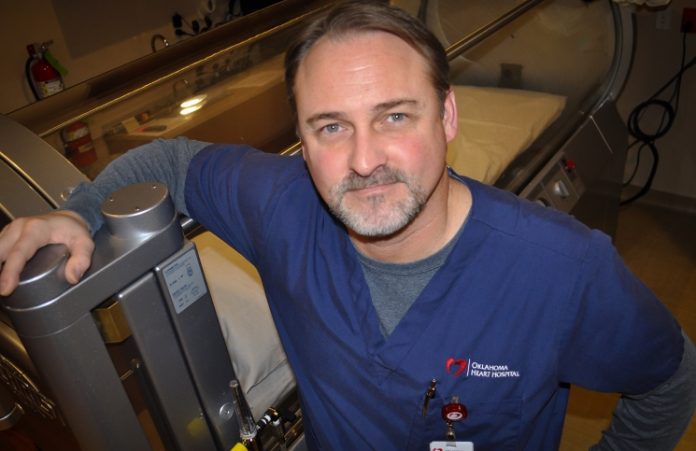by Mike Lee
Staff Writer
Unlike most people who work as hyperbaric techs, John Slayton, LPN, has a much more personal understanding of the machinery he works with on a daily basis.
Navy dive school first taught Slayton how punishing pressure could be.
“They had to take you down to over 300 feet to give you nitrogen narcosis to see how you respond,” Slayton said. “It was awesome. You’re in a hyperbaric chamber but it’s full of water and you have a huge, brass Mark V helmet on. You feel like you’re drunk and then you come up and it’s gone.”
The idea behind the test is to weed out the individuals who can’t handle the nitrogen buildup in their system. No one knows how they will react until they’re 300-feet deep.
The Navy makes this test routine for new divers, but for some it can be an experience.
“It’s like an alcoholic, they might be a normal person until they get drunk and then they just flip on you,” Slayton said of some who panic in the tube. “Most people don’t have a reaction to it. It’s always the last person you would think that tries to take their clothes off.”
But it wasn’t until he worked as a hyperbaric tech that Slayton would encounter all the benefits pressurized oxygen therapy could hold.
Slayton picked up his love for wound care while working at Midwest Regional Hospital. He spent three months doing hyperbaric therapy as a CNA. “I really enjoyed it. The only reason I left was because I got accepted to nursing school,” Slayton said.
Slayton later worked in medical surgical, home health and pediatrics after graduating Metro Tech for his LPN and began working on his RN at Rose State.
Helping raise a granddaughter has put getting his RN on hold for now.
Working at Oklahoma Heart Hospital doing vascular, Slayton noticed OHH would soon be doing hyperbaric therapy.
He showed up for the interview and all the people he had previously worked with at Midwest Regional were doing the hiring.
He fell in love all over again.
“The results,” Slayton said of what keeps him interested. “Some of these people have the same wound for a year and they think they’re at the point where they’re about to lose their leg. Then they go to hyperbarics and four weeks later that’s not even an option any more. And you really get to know these people. It’s not like a normal nursing job where they come even once a week and you see them for 10 or 15 minutes.”
“I spend two hours, five days a week with these people for four weeks or longer. They’re like family and that’s how they look at you, too.”
Obviously, nursing is a second career for Slayton, who spent 14 years in the military. Outside of diving with the Navy he also worked supply and then moved on to the Army and Air Force Reserves.
You might even say it’s a third career, as the 47-year-old Slayton is helping raise a four-year-old granddaughter.
“I wouldn’t have it any other way. I was furious when I found out … but now that little girl is everything,” he said.
Oklahoma Heart Hospital Wound Center opened its doors in January.
The new wound center brings the community treatment and protocols to treat chronic wounds including hyperbaric oxygen therapy, negative pressure therapies, bioengineered tissues and biosynthetics. Patients may also have the opportunity to participate in clinical trials and multicenter studies.
A member of the Healogics network, the wound center employs a rigorous scientific approach to explore, test, find and develop the clinically proven methods and technologies which reintroduce the body’s innate ability to heal. The network, comprised of academic medical centers, hospitals and thousands of professionals is committed to advancing wound healing by creating, sharing, and activating wound prevention and care expertise.
The next few years holds an RN degree for Slayton. He says his hyperbaric experience has been tremendous.
So far he’s shunned the inquiries for him to go into management. For now, he’s happy doing what he’s doing.
“I don’t want to get away from patient care.”












